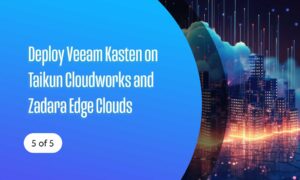Application Delivery is Changing
This is the first of a series of Blog articles to guide you through a modern Application Delivery Platform deployment.
Modern application delivery platforms can be complex ecosystems designed to streamline the development, deployment, and management of business software applications. These platforms integrate various technologies and methodologies to improve speed, efficiency, and scalability. As Zadara has described in its recent ebook, this needs collaboration, competitiveness and compatibility to deliver applications on this level of complexity.
Here’s an overview of their key characteristics:
Cloud-Based Infrastructure: Many modern platforms utilise hyperscale cloud services, such as AWS, Azure, or Google Cloud, to provide flexible, scalable, and cost-efficient computing resources. Cloud-native architectures, including microservices and serverless computing, are common, allowing applications to scale dynamically based on demand.
DevOps Practices: These platforms embrace DevOps principles, which promote closer collaboration between development and operations teams. This integration helps in automating the software development lifecycle, reducing the time and effort required to release new features and fixes.
Continuous Integration and Continuous Delivery (CI/CD): CI/CD pipelines are fundamental components of modern platforms. They automate steps in the software delivery process, such as code commits, builds, tests, and deployments, enabling frequent and reliable updates to production environments.
Containerisation and Orchestration: Technologies like Docker and Kubernetes such as Zadara’s EKS-D play a crucial role in modern application delivery. Containerisation encapsulates applications into containers, ensuring consistency across environments and in different locations that may not be addressed by a hyperscale only approach. Orchestration tools such as Kubernetes manage these containers’ lifecycle, scaling, and networking needs.
Configuration Management and Automation: Tools like Ansible, Chef, and Puppet help automate the configuration and management of software across various environments. This automation supports maintaining consistency and compliance standards, thus reducing human error as the same tasks can be repeated autonomously.
Monitoring and Analytics: Modern platforms include sophisticated monitoring and analytics tools to track application performance, user activities, and system health in real-time. Tools like Prometheus, Grafana, and Elasticsearch are used to gather, analyse, and visualise metrics and logs, this allows value to be derived from this data to support business functions.
Security and Compliance: Security is integrated into the software development lifecycle through practices like DevSecOps. This includes automatic security checks, compliance monitoring, and vulnerability assessments to ensure the application meets security standards throughout its lifecycle. This is imperative in a modern application development framework to minimise risks such as source code compromises and supply chain attacks.
User Experience and Management Interfaces: These platforms often provide intuitive user interfaces and APIs to manage the deployment, scaling, and management of applications easily. They also offer features like auto-scaling, load balancing, and disaster recovery as part of their service.
Overall, modern application delivery platforms are designed to support agile development practices, enabling businesses to adapt quickly to market changes and customer demands while maintaining high standards of quality and security.
This does not mean that we are restricted in terms of the delivery point to hyperscale only clouds. The growth of AI / ML workloads is going to increase the data volumes and the accessibility needs of applications that are time or bandwidth sensitive; this will mean more and more deployments needed at the edge.
Delivering Software as a Service (SaaS) over a distributed edge platform is going to be a key aspect of scaling this capability, Zadara is leading this charge, as it has done in pioneering the Storage as a Service On-premises capability. Building on top of this an Enterprise multi-tenant Infrastructure as a Service capability; however the complexity of modern application delivery has left many organisations confused and uncertain of the way forward to address key business application transformation.
Zadara has built a number of key relationships and partnerships to address these needs, we are proud of the way we build around our customers and our partners capabilities.
Our core Cloud capabilities enable a cloud-native delivery model in any location of choice, on-premises, into our Service Provider partners, attached to Hyperscale providers.
This brings Data Storage Management, AWS compatible infrastructure management and application delivery using Virtual Machines or Containers, all with independent scaling in a multi-tenant environment.
Many organisations think multi-tenancy is for Service Providers only, but think about security and keeping development and production environments separate, multi-tenancy provides business answers without needing dedicated physical separation.
Aggregating delivery platforms to deliver business outcomes requires a horizontal and vertical scaling platform, this needs partnerships and alliances to thrive in this environment.
Moving forward, we are going to demonstrate the modern application delivery platform using Zadara, Taikun Cloudworks and Kasten K10 by Veeam to enable deployment, management, protection and mobility for stateful and stateless applications.
We will demonstrate how to create a Zadara zCompute Account, Project and VPC to provide an isolated environment to deliver a secure application delivery of one or more interconnected applications.
Then we will demonstrate how to integrate Taikun Cloudworks to centrally manage and orchestrate a Kubernetes Cluster across one or more locations and deploy a suite of applications in a controlled manner to provide not only day one deployment but day two management and support.
These Applications need protection just like any other business application. We will demonstrate how to use Kasten K10 by Veeam, deployed as a Cloud native application in its own right to provide backup, DR and mobility of the application data.
We will use Zadara Object Storage with Object-Lock immutability to provide a secure backup location and this can be used as the underpinning storage technology to allow regional or global recovery of these environments.
Our Collaborations enable you to collaborate with your partners and customers simply and easily, we enable your business to compete better and we enable this with an AWS compatible Cloud infrastructure delivered in the location of your choice.
Let us take you on the journey for deploying your organisations future applications.






